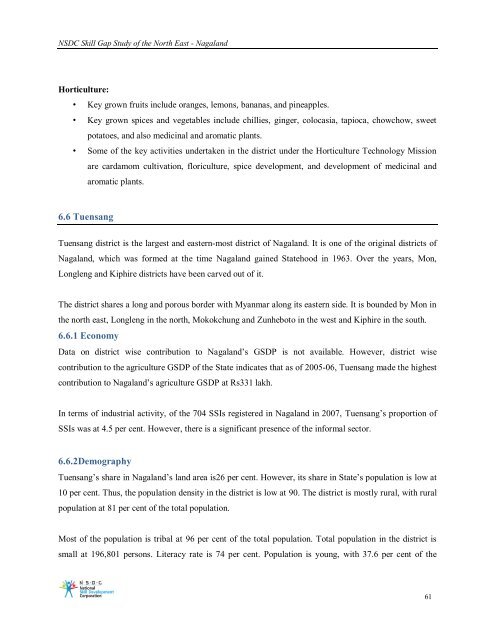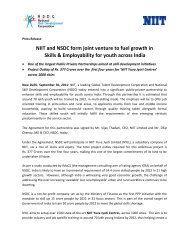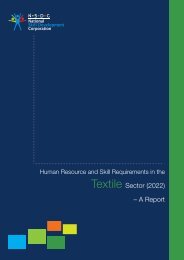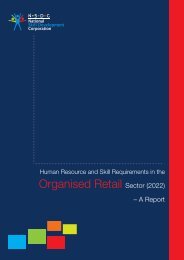Download - National Skill Development Corporation
Download - National Skill Development Corporation
Download - National Skill Development Corporation
You also want an ePaper? Increase the reach of your titles
YUMPU automatically turns print PDFs into web optimized ePapers that Google loves.
NSDC <strong>Skill</strong> Gap Study of the North East - Nagaland<br />
Horticulture:<br />
• Key grown fruits include oranges, lemons, bananas, and pineapples.<br />
• Key grown spices and vegetables include chillies, ginger, colocasia, tapioca, chowchow, sweet<br />
potatoes, and also medicinal and aromatic plants.<br />
• Some of the key activities undertaken in the district under the Horticulture Technology Mission<br />
6.6 Tuensang<br />
are cardamom cultivation, floriculture, spice development, and development of medicinal and<br />
aromatic plants.<br />
Tuensang district is the largest and eastern-most district of Nagaland. It is one of the original districts of<br />
Nagaland, which was formed at the time Nagaland gained Statehood in 1963. Over the years, Mon,<br />
Longleng and Kiphire districts have been carved out of it.<br />
The district shares a long and porous border with Myanmar along its eastern side. It is bounded by Mon in<br />
the north east, Longleng in the north, Mokokchung and Zunheboto in the west and Kiphire in the south.<br />
6.6.1 Economy<br />
Data on district wise contribution to Nagaland‟s GSDP is not available. However, district wise<br />
contribution to the agriculture GSDP of the State indicates that as of 2005-06, Tuensang made the highest<br />
contribution to Nagaland‟s agriculture GSDP at Rs331 lakh.<br />
In terms of industrial activity, of the 704 SSIs registered in Nagaland in 2007, Tuensang‟s proportion of<br />
SSIs was at 4.5 per cent. However, there is a significant presence of the informal sector.<br />
6.6.2Demography<br />
Tuensang‟s share in Nagaland‟s land area is26 per cent. However, its share in State‟s population is low at<br />
10 per cent. Thus, the population density in the district is low at 90. The district is mostly rural, with rural<br />
population at 81 per cent of the total population.<br />
Most of the population is tribal at 96 per cent of the total population. Total population in the district is<br />
small at 196,801 persons. Literacy rate is 74 per cent. Population is young, with 37.6 per cent of the<br />
61






